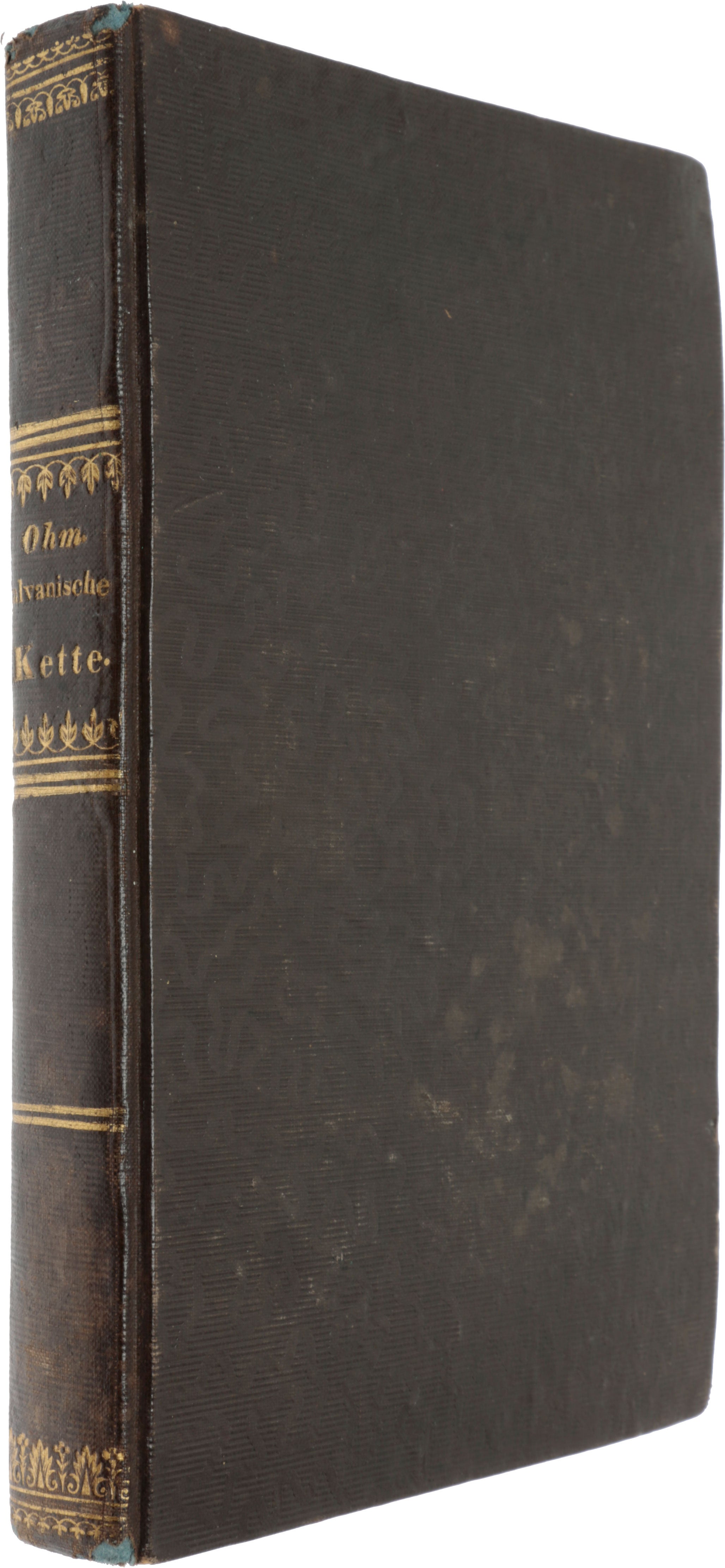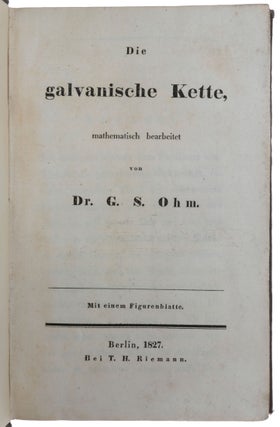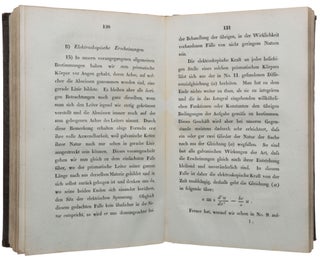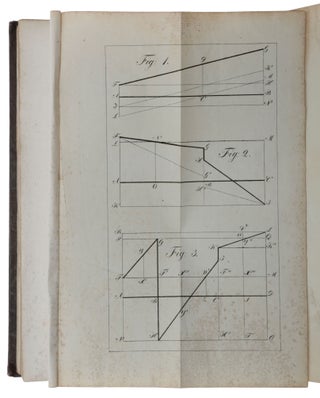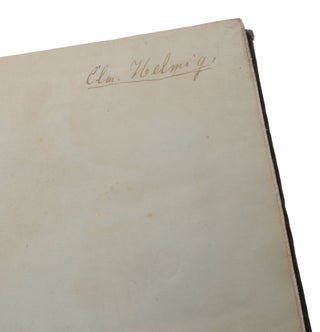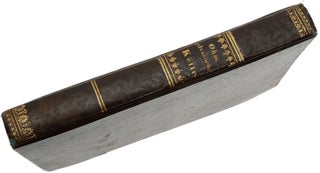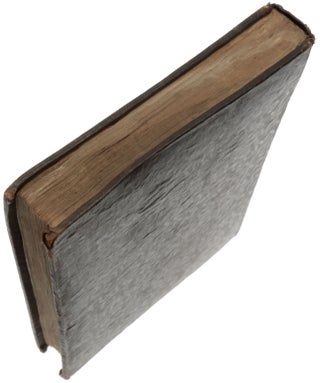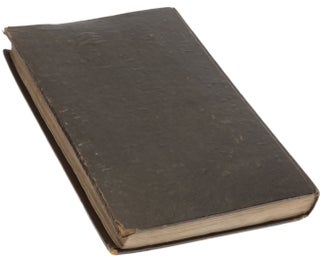Die galvanische Kette, mathematisch bearbeitet.
Berlin: J.G.F. Kniestädt for T.H. Riemann. 1827.
First edition of “Ohm’s great work” (DSB), containing the fully-developed presentation of his theory of electricity, including Ohm’s Law. “Ohm’s great contribution − ‘The Galvanic Chain Mathematically Calculated’ − was to measure the rate of current flow and the effects of resistance on the current. ‘Ohm’s law’ − that the resistance of a given conductor is a constant independent of the voltage applied or the current flowing (that is, C = E/R, where C = current, E = electromotive force and R = resistance) − was arrived at theoretically by analogy with Fourier’s heat measurements (1800-14)” (PMM).
“The expression “investigated mathematically” in the title of Ohm’s book described his objective: to deduce the properties of the galvanic circuit from a set of “fundamental laws.” The first of these laws states that electricity passes only between adjacent particles of the conductor and that the quantity passed is proportional to the difference in electroscopic force at the two particles. Here Ohm drew on an analogy to Fourier’s heat theory, in which the quantity of caloric passed between two particles is proportional to the difference between their temperatures. Ohm’s second law, supported by Coulomb’s experiments, states that the loss of electricity in unit time from the conductor to the air is proportional to the electroscopic force of the electricity, to the amount of surface exposed, and to a coefficient that depends on the air; acknowledging that this second law has little bearing on the phenomena of galvanic currents, Ohm included it to make the theory complete and parallel to Fourier’s theory of heat. The third and last law states that two bodies in contact maintain the same difference of electroscopic force at their common surface, which is the basic tenet of the contact theory of the battery. From these three laws, Ohm derived differential equations for electric currents analogous to Fourier’s and Poisson’s for heat, which indicated to him an “intimate connection” between the two phenomena.
“The mathematical expression of Ohm’s physical analogy between the conduction of electricity and the conduction of heat is an equation identical in form to Fourier’s. The only difference is in the physical significance of the symbols entering the equation: in Fourier’s the independent variable is the temperature; in Ohm’s it is the electroscopic force, which is the force with which an electroscope, a body of constant electrical condition, is attracted to or repelled from a body it is brought into contact with. Following an approach Fourier had made familiar, Ohm mathematically divided the conductor into infinitely thin discs and calculated the quantity of electricity transferred per unit time across the parallel surfaces and outward through the edges of the discs. The result was the fundamental second-order, partial differential equation of Ohm’s theory … Having formulated the physical problem as a differential equation, Ohm then solved it to obtain relations between directly measurable quantities. Manipulating the solution written as an infinite series of sine and cosine functions with damping coefficients, Ohm arrived at … his law relating electric current, resistance, and tension.
“The “torch of mathematics”, Ohm wrote, shines through physics, illuminating its dark places. With his Galvanic Circuit, he could claim that mathematics had “incontrovertibly” possessed a “new field of physics, from which it had hitherto remained almost totally excluded.” By means of mathematical deductions from a few experimental “principles,” galvanic phenomena had been brought together in “closed connection” and presented as a “unity of thought.” The deductions showed that the seemingly disparate phenomena of electric tension and current are really connected in nature, partially realizing Ohm’s goal of fashioning the theory of electricity as a “whole” …
“When the Galvanic Circuit appeared, few physicists in Germany knew mathematical physics sufficiently to understand it. Journal editors were afraid their readers could not understand papers containing the simplest mathematics, as Ohm complained. For reviewing, Ohm sent a copy of his book to Schweigger at Halle, who did not see the point of a mathematical treatment. To have it evaluated, the Prussian minister of culture sent a copy to Kämtz, Schweigger’s colleague at Halle, who could not follow the mathematical derivation, as is clear from his cautious review of it. In Berlin, which desperately needed a “mathematical physicist,” Ohm’s work received its most famous and, to Ohm, irritating review from Pohl, who was neither a mathematical nor a typical Berlin physicist … [Pohl] complained that Ohm had not paid attention to the “essence” of the circuit and had merely expressed some properties of electricity in formulas. This was no achievement but only a replication of Fourier’s and Poisson’s work in another part of physics … In general, the response to Ohm’s book reflected a paucity of physicists with good mathematical knowledge in Germany in the late 1820s. But one German review of Ohm’s book showed complete comprehension. Ohm sent his book to Kastner in Erlangen to be reviewed in his journal. Kastner asked the mathematician Wilhelm Pfaff to write the review, but Pfaff did not know the literature … The review that appeared under Pfaff’s name was apparently written by Ohm himself, after his brother had interceded. The review was, of course, favourable, but a favourable review does not necessarily make a successful book. Sales of the Galvanic Circuit were unimpressive, and Ohm paid friends to order the book from out of town to make a better impression on the publisher. The book was in print for eight years, then not again for sixty years, though in the meantime it had come out in several translations. Ohm sent free copies to everyone who might help him, as he did not want to return to his teaching in Cologne” (Jungnickel & McCormmach, pp. 53-7).
Georg Simon Ohm (1789-1854) was educated, together with his brother Martin, the mathematician, principally by his father, who gave his sons a solid education in mathematics, physics, chemistry, and the philosophies of Kant and Fichte; their considerable mathematical ability was recognized in 1804 by the Erlangen professor Karl Christian von Langsdorf, who enthusiastically likened them to the Bernoullis. Ohm received his Ph.D. from the University of Erlangen in 1811, but after teaching there for three semesters as a Privatdozent, he was only able to find employment as a schoolteacher, first at Bamberg and then from 1817 at the recently reformed Jesuit Gymnasium at Cologne. “The ideals of wissenschaftliche Bildung had infused the school with enthusiasm for learning and teaching; and this atmosphere which appears later to have waned, coupled with the requirement that he teach physics and the existence of a well-equipped laboratory, stimulated Ohm to concern himself for the first time avidly with physics. He studied the French classics − at first Lagrange, Legendre, Laplace, Biot, and Poisson, later Fourier and Fresnel − and, especially after Oersted’s discovery of electro-magnetism in 1820, did experimental work in electricity and magnetism. It was not until early in 1825, however, that he undertook research with an eye toward eventual publication” (DSB).
“Feeling increasingly burdened by his teaching at a secondary school in Cologne, Ohm took his father’s advice and asked the Prussian minister of culture for a year off. To the minister he explained that for a long time he had divided his attention between mathematics and physics, though for practical reasons he had emphasized physics. By taking up physics he did not have to give up mathematics, he said, since the two were closely connected. His appeal to the minister contained an element of calculation: he regretted that the French had recently dominated physics, and he had been studying the mathematical works by Laplace, Fourier, Poisson, Fresnel, and other French masters to see what they had left for him to do. He had been doing purely experimental work on the whole, but he had in hand a mathematical theory of galvanic current; all he needed was time off to complete it and, he added, to work out a theory of light as well. On the recommendation of Ermann, the minister approved Ohm’s request. With half salary, Ohm went off to Berlin in 1826 to live in his brother’s house, where he had a small apartment with space for doing experiments. With these improved working conditions, he developed the mathematical theory of the galvanic current, perhaps with his brother’s help with the calculations. The result was the Galvanic Circuit …
“After the Galvanic Circuit, Ohm carried out important researches on tones and on crystal optics, and he undertook a comprehensive theory of physics. In the year the Galvanic Circuit was published, he began to speak of a greater work to come, one that would treat the whole of molecular physics. Apparently he wanted to derive all physical phenomena from analytical mechanics and molecular hypotheses. Ohm published the first volume containing the mathematical preliminaries. In the second volume he intended to treat dynamics and in the third and fourth its application to physical phenomena. But Ohm’s late call to Munich University interfered with his plan, and the volumes never appeared. The existence of the plan, however, pointed to the confidence of the author of the Galvanic Circuit in the power of mathematical physics to complete the understanding of nature that Newton had begun” (Jungnickel & McCormmach, pp. 53-8).
Widespread understanding and acknowledgement of the importance of the Galvanic Circuit did not come until the late 1830s and early 1840s, when Ohm’s work began to receive official recognition, with corresponding memberships of the Berlin and Turin academies in 1839 and 1841 respectively, the award of the Royal Society of London’s Copley Medal in 1841 and finally (just before his death), the chair of physics at the University of Munich in 1852. In 1881, when the importance of Ohm’s work was fully understood, the standard unit of electrical resistance was named the ohm in his honour at the Paris Conference on international standards.
Waller 11419; Wellcome IV, p. 260; Wheeler Gift Cat. 835. Jungnickel & McCormmach, Intellectual Mastery of Nature. Theoretical Physics from Ohm to Einstein, Volume 1: The Torch of Mathematics, 1800 to 1870, 1990.
8vo (195 x 123 mm), pp. iv, 245 (errata on p. 245), 1 folding engraved plate. Contemporary patterned German cloth, gilt spine lettering, light wear to capitals and corners. Previous owner's signature removed from title. Custom half leather clamshell box.
Item #5475
Price: $25,000.00

